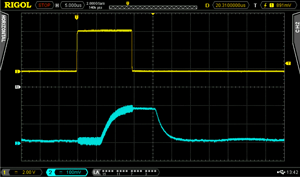Approximation method for calculation of output response parameters of acousto-optic demodulator on pulsed input influence
DOI:
https://doi.org/10.3103/S0735272723070051Keywords:
demodulation, pulse, acousto-optic, rise time, transient response, approximation model, photodetectorAbstract
In this paper, there are represented the features of acousto-optic interaction in the context of pulse signal detection. It specifies the necessity of the development of a simpler method for the calculation of a demodulator output signal parameters in case of its feeding with a pulse signal. Approximation models of modulating pulse and a pulse of the photodetector’s output were made based on geometric representation of the photo-elastic interaction. It is shown the main parameter defining the shape of the output pulse is the inertia of the acousto-optic demodulator. It is postulated that this parameter is shaped due to the influence of two factors: an acoustic-optic interaction and a photodetector inertia. For estimation of the degree of influence of these factors, a numerical analysis based on developed models is carried out. The results of theoretic research and numerical analysis are verified with experimental research. It is stated that for the application of a high-performance photodetector, the inertia of the acousto-optic demodulator is defined mainly by space-time parameters of acousto-optic interaction.
References
- E. Yar, M. B. Kocamis, A. Orduyilmaz, M. Serin, M. Efe, “A complete framework of radar pulse detection and modulation classification for cognitive EW,” in 2019 27th European Signal Processing Conference (EUSIPCO), 2019, pp. 1–5, doi: https://doi.org/10.23919/EUSIPCO.2019.8903045.
- A. M. Rembovskiy, A. V. Ashimikhin, V. A. Kozmin, Radiomonitoring: Problems, methods, equipment, [in Russian]. Moscow: Goryachaya Liniya-Telekom, 2015.
- V. V. Proklov, V. N. Ushakov, Acousto-Optic Processors of Spectral Type, [in Russian]. Moscow: Radiotekhnika, 2012.
- C. C. Davis, Lasers and Electro-Optics. Cambridge: Cambridge University Press, 2013, doi: https://doi.org/10.1017/CBO9781139016629.
- V. I. Balakshii, V. N. Parygin, L. E. Chirkov, Physics of Acoustooptics, [in Russian]. Moscow: Radio i Svyaz’, 1985.
- J. N. Lee, A. Vanderugt, “Acoustooptic signal processing and computing,” Proc. IEEE, vol. 77, no. 10, pp. 1528–1557, 1989, doi: https://doi.org/10.1109/5.40667.
- V. Y. Molchanov et al., Theory and practice of current acousto-optics, [in Russian]. Moscow: MISiS, 2015.
- H. C. Feng, B. Tang, T. Wan, “Radar pulse repetition interval modulation recognition with combined net and domain-adaptive few-shot learning,” Digit. Signal Process., vol. 127, p. 103562, 2022, doi: https://doi.org/10.1016/j.dsp.2022.103562.
- A. Y. Solodovnikov, N. A. Kuptsov, V. M. Kunitsyn, A. A. Glizhinskiy, “Analysis of probing signals of radar of radio technical troops,” Alleya Nauk., vol. 1, no. 3, pp. 40–47, 2019.
- A. Hasanov et al., “Development of an axonometric model of photoelastic interaction in an acousto-optic delay line and its approbation,” Technol. Audit Prod. Reserv., vol. 5, no. 2(67), pp. 38–45, 2022, doi: https://doi.org/10.15587/2706-5448.2022.267782.
- A. R. Hasanov, R. A. Hasanov, R. A. Ahmadov, M. V. Sadikhov, “Approximation method for investigating acousto-optic delay line characteristics,” Radioelectron. Commun. Syst., vol. 64, no. 11, pp. 604–611, 2021, doi: https://doi.org/10.3103/S0735272721110042.
- F. Akhmedzhanov, S. Mirzaev, U. Saidvaliev, “Singularities of anisotropy of acoustic attenuation in paratellurite crystals,” in Proceedings of Meetings on Acoustics, 201845045, doi: https://doi.org/10.1121/2.0000937.
- H. Zhang, H. Zhao, Q. Guo, Y. Xuan, “Calibration of acousto-optic interaction geometry based on the analysis of AOTF angular performance,” Materials, vol. 16, no. 10, p. 3708, 2023, doi: https://doi.org/10.3390/ma16103708.


